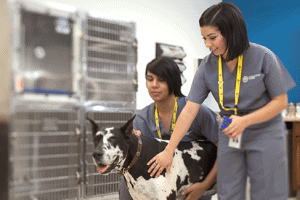 Just like people, our pets have blood pressure too and they also risk developing high blood pressure. While high blood pressure in humans can cause more serious health issues, high blood pressure in animals is usually associated with a more critical health issue, because hypertension is typically the result of an existing underlying disease. High blood pressure in dogs is often associated with Cushing’s disease or hyperadrenocorticism. Cushing’s disease is when a disorder, usually a benign tumor, allows an excess of cortisone to be released into the blood stream. Cats often develop high blood pressure as a result of having hyperthyroidism and/ or kidney disease. Hyperthyroidism is an overproduction of a thyroid hormone that results in an increased metabolism.
Just like people, our pets have blood pressure too and they also risk developing high blood pressure. While high blood pressure in humans can cause more serious health issues, high blood pressure in animals is usually associated with a more critical health issue, because hypertension is typically the result of an existing underlying disease. High blood pressure in dogs is often associated with Cushing’s disease or hyperadrenocorticism. Cushing’s disease is when a disorder, usually a benign tumor, allows an excess of cortisone to be released into the blood stream. Cats often develop high blood pressure as a result of having hyperthyroidism and/ or kidney disease. Hyperthyroidism is an overproduction of a thyroid hormone that results in an increased metabolism.
Taking a Pet’s Blood Pressure
Measuring a pet’s blood pressure is often done the same way as it is with humans. An inflatable cuff is placed on the dog’s leg or tail, and standard blood pressure measuring instruments check the pressure. One difficulty can be keeping the dog still long enough to get an accurate reading, and that’s important. Veterinarians have to calculate another number when taking a dog or cats blood pressure called MAP or Mean Arterial Pressure. A dog’s or cat’s MAP is calculated by dividing the diastolic pressure + 1/3 by the systolic pressure – diastolic pressure.
| Animal | Systolic | Diastolic | MAP |
| Dogs * | 110-160 | 85-120 | 85-120 |
| Cats | 110-160 | 85-120 | 85-120 |
| Mice | 120 | 71 | |
| Rats | 129 | 91 | |
| Giraffe | 280 | 180 | |
| Horse | 112±14 | 70±14 | |
| Elephant | 178.6 +/- 2.94 | 118.7 +/- 3.10 |
* Some variation depending on breed.
 If your pet has already been diagnosed with, and is being treated for, hypertension, your veterinarian will need to treat the underlying condition that caused the high blood pressure. They will probably also want to measure your pet’s blood pressure every three months moving forward. The vet may also suggest performing other tests, such as a complete blood count, blood chemistry panel and a urinalysis, every six months. For most of us our pets are part of the family, so make sure they get a regular annual check-up with their veterinarian. Don’t ignore your vet’s advice, or at least get a second opinion before you make a potentially life and death decision on your fur-baby’s behalf.
If your pet has already been diagnosed with, and is being treated for, hypertension, your veterinarian will need to treat the underlying condition that caused the high blood pressure. They will probably also want to measure your pet’s blood pressure every three months moving forward. The vet may also suggest performing other tests, such as a complete blood count, blood chemistry panel and a urinalysis, every six months. For most of us our pets are part of the family, so make sure they get a regular annual check-up with their veterinarian. Don’t ignore your vet’s advice, or at least get a second opinion before you make a potentially life and death decision on your fur-baby’s behalf.
Sources:
- https://www.kentscientific.com/Products/Specs/SpecPopUp.asp?Mode=FAQ&SpecId=181
- http://www.giraffeconservation.org/giraffe_facts.php?pgid=4
- http://en.wikivet.net/Blood_Pressure_Reference_Ranges
- http://www.petmd.com/dog/conditions/endocrine/c_dg_hyperadrenocorticism
- http://www.petmd.com/cat/conditions/endocrine/c_ct_hyperthyroidism
- www.elephanttag.org



